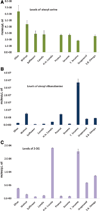Levels of bioactive lipids in cooking oils: olive oil is the richest source of oleoyl serine
- PMID: 26565552
- PMCID: PMC4959147
- DOI: 10.1515/jbcpp-2015-0104
Levels of bioactive lipids in cooking oils: olive oil is the richest source of oleoyl serine
Abstract
Background: Rates of osteoporosis are significantly lower in regions of the world where olive oil consumption is a dietary cornerstone. Olive oil may represent a source of oleoyl serine (OS), which showed efficacy in animal models of osteoporosis. Here, we tested the hypothesis that OS as well as structurally analogous N-acyl amide and 2-acyl glycerol lipids are present in the following cooking oils: olive, walnut, canola, high heat canola, peanut, safflower, sesame, toasted sesame, grape seed, and smart balance omega.
Methods: Methanolic lipid extracts from each of the cooking oils were partially purified on C-18 solid-phase extraction columns. Extracts were analyzed with high-performance liquid chromatography-tandem mass spectrometry, and 33 lipids were measured in each sample, including OS and bioactive analogs.
Results: Of the oils screened here, walnut oil had the highest number of lipids detected (22/33). Olive oil had the second highest number of lipids detected (20/33), whereas grape-seed and high-heat canola oil were tied for lowest number of detected lipids (6/33). OS was detected in 8 of the 10 oils tested and the levels were highest in olive oil, suggesting that there is something about the olive plant that enriches this lipid.
Conclusions: Cooking oils contain varying levels of bioactive lipids from the N-acyl amide and 2-acyl glycerol families. Olive oil is a dietary source of OS, which may contribute to lowered prevalence of osteoporosis in countries with high consumption of this oil.
Figures

References
-
- Johnell O, Kanis JA. An estimate of the worldwide prevalence and disability associated with osteoporotic fractures. Osteoporos Int. 2006;17:1726–1733. - PubMed
-
- Kanis J on behalf of the WHO Scientific Group. Technical report. University of Sheffield, UK: WHO Collaborating Centre for Metabolic Bone Diseases; 2007. Assessment of osteoporosis at the primary health care level; p. 66.
-
- Fistonic I, Situm M, Bulat V, Harapin M, Fistonic N, Verbanac D. Olive oil biophenols and women’s health. Med Glas (Zenica) 2012;9:1–9. - PubMed
-
- Garcia-Martinez O, Rivas A, Ramos-Torrecillas J, De Luna-Bertos E, Ruiz C. The effect of olive oil on osteoporosis prevention. Int J Food Sci Nutr. 2014;65:834–840. - PubMed
MeSH terms
Substances
Grants and funding
LinkOut - more resources
Full Text Sources
Other Literature Sources
